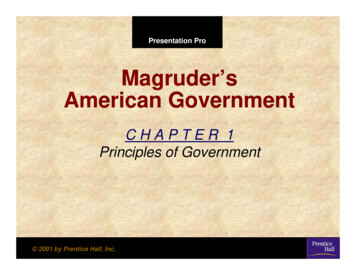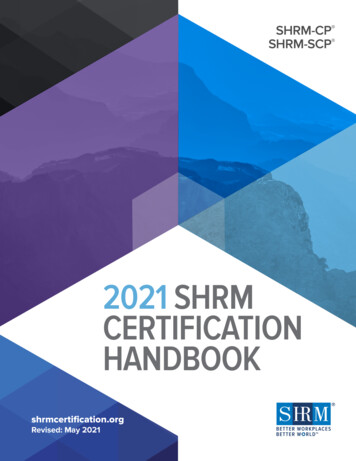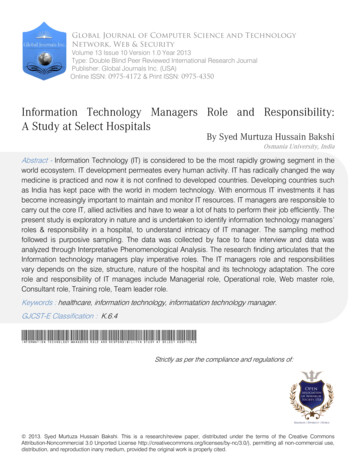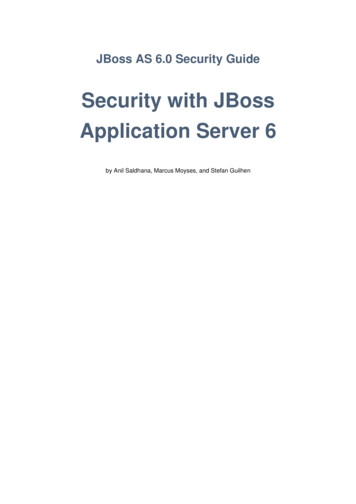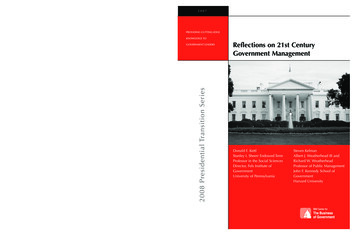
Transcription
THE ROLE OF THE GOVERNMENT IN CONSUMERPROTECTION: THE CONSUMER FRAUDS ANDCRIMES SECTION OF THE OFFICE OFTHE OHIO ATTORNEY GENERALHON. WILL AB. SAxBE*That government should have a major role to play in the protection of the consumer is a comparatively new idea. The trendtoward increased governmental intervention between buyer andseller is the result not of visionary political idealism, but rather offundamental factors currently at work in the economic marketplace.In an economy that places great emphasis on technological innovation and complexity, and given the subtle sophistication of modemadvertising, the consumer has lost much of the equality of bargainingposition vis-4-vis the seller he once had. The role of governmentshould be to insure a balance between buyer and seller in themarketplace. Only if there is a fundamental equality of bargainingposition between buyer and seller can there be the efficient allocation of resources necessary for the operation of a free enterpriseeconomy. Hence, the goal of government in the protection of theconsumer is not to regulate the legitimate businessman, but to ensure that he alone reaps the deserved benefits of his enterprise.I. ORGANIZATION AND DEVELOPMENT OF THE CONSUMER FRAUDS ANDCRINMES SECTIONThere is no specific statutory enabling authority for the Con-sumer Frauds and Crimes Section of the Office of the Ohio AttorneyGeneral. Rather, it operates under the attorney general's statutorypower to act as "chief law officer for the state and all its departments."' The lack of specific authority has not been a hindranceto the present development of the Section.2The staff of the Section consists of a Chief,3 who is directlyUnited States Senator-Elect; Attorney General, State of Ohio; L.L.B., Ohio StateUniversity College of Law.1 OHio REv. CODE ANN. § 109.02 (Page 1962).2 Note, however, that discussions on the federal level in the House of Representafives have brought about the possibility that only state created agencies may receivefederal grants-in-aid for state consumer protection programs.3 Currently Colonel George Mingle, whose previous experience includes Superintendent of the Ohio State Highway Patrol and City Mfanager of Portsmouth, Ohioand Delray Beach, Florida.
OHIO STATE LAW JOURNAL[Vol. 29responsible to the First Assistant Attorney General, two lawyers,three investigators, and administrative personnel. The section usesother lawyers within the office when they are needed.All activity is centralized in the Attorney General's Columbusoffice. While field offices enable a state agency to reach a greaternumber of local problems, they also cause a separation of the limitedresources available. The tendency may be to deal with immediatelocal problems, and consequently concern with long range problemsis diminished. In short, decentralization can lead to an inability tosee the forest for the trees.4 The Federal Trade Commission, withits nationwide scope of operations, has found the need to createeleven regional offices.5 In Ohio, however, decentralization does notbecome a necessary goal, since an investigator can be in any part ofthe State within several hours. Added to this is the state's built-inform of decentralization-the local governmental authorities. A prerequisite of effective enforcement is the willingness of local authorities to bring problems to the immediate attention of the Attorney General's office. Since the Section has no statutory enforcementpowers, and because under existing law the attorney general has fewpowers that relate directly to consumer protection, the Section islargely dependent on these other governmental authorities for enforcement when legal action is appropriate.II.COORDINATION WITH GOVERNMENTAL AND PRIVATEORGANIZATIONSA central purpose of the Consumer Frauds and Crimes Sectionis to coordinate the exchange of consumer information with othergovernmental and private organizations. This relationship is reciprocal. The Section seeks to help keep local prosecutors and policeabreast of legal developments, fraudulent schemes, and operatorswho may be working in areas of local responsibility. On the otherhand, local authorities inform the Section about fraudulent operations on a statewide level. The information coming in to the Sectionis then relayed to other officials throughout the state.The Better Business Bureaus and other state consumer agenciesare also invaluable sources of information about deceptive businesspractices. Other agencies of the State of Ohio are directly involved inconsumer protection programs relating to food, drugs, insurance,4 But see O'Connell, Consumer Protection in the State of Washington, 39 STATIgGov'T 230, 235-37 (1966).5 Annual Report of the Federal Trade Commission iii (1967).
1968]STATE CONSUMER PROTECTIONsecurities, real estate and weights and measures. The Section cooperates with these agencies in the investigation of complaints arising inareas of their responsibility.The Section has established a close relationship with the FederalTrade Commission through the exchange of legal and factual materials of common interest. This information is limited primarily tothe regulation of interstate transactions, but fraudulent operatorsfind it increasingly easy to cross state lines to avoid local prosecutionor regulation. This is a situation which necessitates close state andfederal cooperation. State officials often find it necessary to enlist thehelp of the FTC in tracking down mobile operators moving in andout of their areas.In recent years the FTC has taken an increased interest in stateconsumer protection programs.0 Mr. Gale Gotschall, the FTC Assistant General Counsel for Federal-State Cooperation, admits that theFTC is hard pressed to deal with deceptive practices on the nationallevel and therefore lacks the manpower and resources to deal adequately with local deceptive practices.7 An increased interest inlocal operations is necessary, however, "to nip unfair and deceptivepractices in their incipiency,"8 and prevent them from reachinginterstate proportions. In furtherance of this policy, the FTC provides source materials to state agencies drafting consumer legislation.When the mails are used to defraud, federal postal authoritiesare a source of valuable help to the Section. The Postmaster Generalis expressly required to prevent the mails from being used to carryout fraudulent schemes.* The penalty for violation of these statutesis, of course, criminal in nature and the postal fraud statutes reachonly flagrantly deceptive practices. However, within the scope oftheir application, they are very effective. For instance, a fraudulentpractice, whereby a businessman is sent an advertisement that ismisrepresented as an invoice for his inclusion in a business directory,is now by statute non-mailable matter.**Because there is a great need for coordination of effort of bothprivate and governmental consumer agencies, the Section is con6 See Dixon, Federal-State Cooperation to Combat Unfair Trade Practices, 39STATE GoV'T 37 (1966).'Address by Mr. Gotschall, Western Conference of the National Association ofAttorneys General, Sept. 2, 1966.8 Address by Mr. Gotschall, Committee of the Massachusetts General Court, July10, 1967.- 39 U.S.C. §§ 4001, 4005 (1964).** Fed. Rev. and Salary Act of 1967, § 118, 81 Stat. 613.
OHIO STATE LAW JOURNAL[Vol. 29tinually expanding its cooperative efforts to such organizations asthe Federal Communications Commission, the Ohio State UniversityAgricultural Extension Service and the various agencies supplyinglegal aid services to the poor. Compounding this need for cooperation is the growth of specialized agencies within the various branchesof government. The resulting problems include duplication of effortand lack of knowledge of the scope of each agency's activities. It isapparent that, in such a complex governmental system, coordinationof effort is a paramount goal in the implementation of worthwhileconsumer protection programs.III. THECOMPLAINT AND INVESTIGATIVE PROCESSA further source of information, and somewhat of an end initself to the operation of the Section, is the processing and investigation of complaints about allegedly deceptive practices. Complaintsare the chief source of information for the Section, and it is essential for the adjustment of claims and for the preparation for litigation that evidence at this first stage of processing be well documented.Each complaint is therefore reduced to a written report and filed.The topics and the parties involved are filed according to the frequency with which they are the subject of complaints. Among themore common subjects of complaints are chain referral selling, homeimprovement sales, fly-by-night schools and diploma mills, "bait-andswitch" advertising techniques, false prizes and "lucky drawings,"lotteries, and usurious interest rates and carrying charges. Complainants include private individuals, business organizations, state officialsand officials of other states, Better Business Bureaus and such federalagencies as the Federal Trade Commission and the Federal Communications Commission. In answer to a questionnaire circulatedby the Section, local agencies have expressed a desire to strengthenthis reciprocal arrangement through regional conferences whichwould stress the exchange of pertinent information. Consequently,area meetings are in the planning stage.After the complaint is received or referred to the Section fromone of the various state or federal agencies, it must be evaluated todetermine whether the elements of fraud and deception are indicated. If it appears that only a difference of opinion is involved, arepresentative of the Section describes the functions of the Sectionto the complainant and suggests that he consider a private attorney.If the complaint appears to have merit, an investigator interviews the seller to discover the relevant facts of the allegedly fraudu-
1968]STATE CONSUMER PROTECTIONlent transaction. The name of the Attorney General must not beused as a dub by buyers who are simply disgruntled as the resultof a bad bargain. A legitimate businessman may be cowed by thefear of unfavorable publicity resulting from an investigation by theAttorney General's Office. The investigator, therefore, attempts tomake it dear that the Attorney General's Office will not take actionuntil the probability of misconduct is established. As a result, contract rescissions and refunds are often made to the mutual satisfaction of buyer and seller.If a complaint and the seller's response indicate the likelihoodof fraudulent or deceptive practices, the Section must seek out anappropriate enforcement authority. Because the Attorney General'sOffice has only narrow enforcement powers, it is essential that theSection establish a proper rapport with authorities who can dealwith the fraudulent seller. The Section does this by indicating itswillingness to cooperate with the appropriate authorities in furtherfactual investigation. It is not only essential to establish cooperationwith the various enforcement agencies of the state and federal government, but a proper relationship must also be established withlocal police agencies, since they are often a vital link in the factgathering process.IV. USE OF EXISTING GovERNMENTAL ENFORCEfMENT POWERSIf investigation indicates a probability of fraud on a broadscale and informal settlement appears inadequate to serve the publicinterest, the availability of legal remedies must be ascertained. Because the enforcement authority in the consumer fraud area is vestedin agencies on the local, state and federal levels of government, it isnecessary to ascertain which agency has the paramount interest in thematter at hand. The results of investigations may then be turnedover to the appropriate agency for its unilateral action. However, ifthe resources of the appropriate agency are taxed by existing problems, as is frequently the situation, for example, in county prosecutors' offices, the cooperation of the Attorney General's Office issometimes offered.A. The Criminal Law as a Tool for Consumer ProtectionIn some situations, the county prosecutor in Ohio has the criminal law available to help him protect the public against fraudulentsellers.Since consumer frauds typically involve some type of fraudulent
OHIO STATE LAW JOURNAL[Vol. 29or false pretense by which the operator induces the owner to partwith his goods, the Ohio larceny statute,0 which requires a trespassory taking without the owners consent, is usually not applicable.The Ohio false pretenses statute' applies to the obtaining ofanything of value, with intent to defraud, by false pretenses or falsestatements. This includes the obtaining of a signature under falsepretenses. The effectiveness of this statute, especially in the area ofconsumer frauds and crimes, has been vitiated by judicial holdingsthat the fraud must relate to a past or present fact or event, not apromise relating to the future. This rule has been squarely appliedin Ohio. 1 The courts feel this restriction necessary to avoid a floodof prosecutions initiated by victims of bad bargains, and to preventfaith, were simply unable to perconviction of those who, in good12form their contractual promises.If one has obtained title or possession to property by consent,and if such consent was induced by a "false or fraudulent representation, pretense, token or writing," the larceny by trick statute" willapply. This statute is usually used as a sword for defrauded sellers orcreditors, and it has been only infrequently applied to protect consumers. In State v. Singleton,'4 however, an Ohio Court of Appeals,using the Ohio larceny by trick statute, affirmed the conviction ofan unlicensed automobile dealer who promised to deliver new carsin the future after a present payment. The court held that, unlikethe crime of false pretenses, larceny by trick did apply to the promiseof a future fact, event or transaction. It was further held that givingpromissory notes to the victims and the use of innocent salesmen asconduits to make the misrepresentations were not defenses to thecomplaint, since they were both an integral part of the fraudulentscheme.The Supreme Court of Ohio has applied the larceny by trickstatute to a vendor of real property who intentionally misrepre9OHIo REV. CODE ANN. § 2907.20 (Page Supp. 1967).10 OHIo REV. CODE ANN. § 2911.01 (Page Supp. 1967). The Attorney General Isexpressly authorized to assist county prosecutors in the prosecution of violators ofthis section.11 Harris v. State, 125 Ohio St. 257, 181 N.E. 104 (1932); Horton v. State, 85Ohio St. 13, 96 N.E. 797 (1911); State v. Gibbs, 9 Ohio N. P. (n.s.) 129 (C. P. Huron1909), afJ'd, 82 Ohio St. 456, 92 N.E. 1123 (1910); Dillingham v. State, 5 Ohio St. 280(1855); See Note, Intent in Larceny by Trick in Ohio, 3 W. RES. L. REV. 160 (1951):Pearce, Theft by False Promises, 101 U. PA. L. REv. 967 (1953).12 See, e.g., Chaplin v. United States, 157 F.2d 697, 699 (D.C. Cir. 1946).13 OHIo REV. CODE ANN. § 2907.21 (Page Supp. 1967).14 85 Ohio App. 245, 87 N.E.2d 358, app. denied, 85 Ohio App. xxxvi (1949).
1968]STATE CONSUMER PROTECTIONsented he had good title and did not notify the purchaser that theland was encumbered by a mortgage or that there were delinquenttaxes. 15 The court held it was not necessary to prove a specific intentto deprive the purchaser of the purchase price permanently.False advertising and "bait-and-switch" advertising are nowprohibited under Ohio Revised Code section 2911.41, the so-calledfalse advertising statute. 16 The first paragraph of the statute substantially codifies the Printer'sInk magazine Model Statute of 1911.No person, firm, or corporation shall directly or indirectlymake, publish, disseminate, circulate, or place before the public,in this state, in a newspaper, magazine, or other publication, orin the form of a book, notice, handbill, poster, circular, pamphlet, letter, sign, placard, card, label, or over any radio station,or in any other way, an advertisement or announcement of anysort regarding merchandise, securities, service, employment, realestate, or anything of value offered by him for use, purchase,or sale, and which advertisement or announcement contains anyassertion, representation, or statement which is untrue, orfraudulent.This portion of the statute has yet to be used to its fullest extent andonly one recent case, State v. Blind Associates Inc., 7 has applied thestatute. The limited holding in that case was that the false advertising statute applies to telephone solicitations.Another common fraudulent practice, now expressly prohibitedby the second paragraph of the false advertising statute, is the "baitand-switch" tactic.No person, firm, or corporation shall, in any manner, or byany means of advertisement, or other means of communication,offer for sale any merchandise, commodity, or service, as part ofa plan or scheme with the intent, design, or purpose not to sell15 State v. Healy, 156 Ohio St. 229, 102 N.E.2d 233 (1951). See also Kellogg v.State, 26 Ohio St. 15 (1874); Miller v. State, 20 Ohio L. Abs. 408 (Ct. App. 1935);Eiseman & Landsman v. State, 12 Ohio L. Abs. 145 (Ct. App. 1932); Note, Intent inLarceny by Trick in Ohio, 3 W. Ras. L. REV. 160 (1951).16 The county prosecutor is given authority to enjoin repeated violations ofthis statute. OHIo REv. CODE ANN. § 2911.42 (Page 1962). See also Note, Developmentsin the Law-Deceptive Advertising, 80 HARv. L. REv. 1005, 1124-25 (1967). Althoughthere is a conflict in the Ohio case law, the better view, from the standpoint of con-sumer frauds, is that an intent to deceive need not be proved. See State v. Schaengold,13 Ohio L.Rep. 130 (Mun. Ct. 1915); Straum v. State, 15 Ohio App. 32 (1921) (dictum).Contra, Rosenblatt v. Cleveland, 20 Ohio L. Abs. 106 (Ct. App. 1935). Cf. State v.Lubell, 28 Ohio N. P. (ns.) 155 (Toledo Mun. Ct. 1930). See cases collected in Note,The Regulation of Advertising, 56 CoLum. L. REv. 1018, 1058-1065 (1956).17 4 Ohio Misc. 129, 217 N.E.2d 43 (C. P. Lake 1965).1
OHIO STATE LAW JOURNALVo[VCol. 29the merchandise, commodity, or service so advertised at theprice stated therein, or with the intent, design, orpurpose not tosell the merchandise, commodity, or service so avertised.An attractive price is used to entice the customer to the seller'splace of business. Once there, the customer is told, or finds out,that the advertised product is inferior and the salesman "switches"him to a higher priced product which is represented as a better deal.Despite the widespread use of such a tactic, there has been littleenforcement of this portion of the statute. The basic reason for thisis the difficulty involved in prosecution of the offense. First, thestatute does not apply to good faith broadcasters or publishersthrough whom most of the bait-and-switch tactics are used. Second,the intent to deceive must be proved. The effect of the latter requirement is to bring about an almost insurmountable problem of proofof facts necessary to constitute the offense.Thus, the main criminal law tools available in Ohio to protectthe consumer"" at best reach only the more flagrant types of consumer frauds and deceptions. Even when they are applicable, localofficials often are not able to enforce these statutes because theirresources are taken up by other problems?10 It is therefore apparentthat the criminal law alone can never be the mainstay of a comprehensive consumer protection program.B. Intervention in Civil Cases Involving a Public InterestThe use of amicus curiae briefs by the Office of the AttorneyGeneral can be very effective when a statute of widespread interest tothe consumer is at issue. The amount of money involved in eachcase, however, is usually so small that the consumer himself does notfeel that full-scale litigation is warranted. As a result, the Office ofthe Attorney General has filed amicus curiae briefs on behalf of theconsumer parties in only two cases. In Fairfax Family Fund, Inc. v.Swartout 20 an amicus brief was filed on behalf of a defendant who18 In addition to these better known criminal statutes, the Ohio Revised Codealso proscribes other lesser known frauds which may be used to defraud consumers.The sending of letters or instruments with the intent to defraud is expressly pro.hibited. OHIO REV. CODE ANN. § 2911.34 (Page 1962). The Code provides comprehen.sive protection for investors against fraudulent stock brokers. Ou1o REV. CODE ANN.§§ 2911.04-.10 (Page 1962). Other types of frauds which are of limited public Interestare also prohibited under OHIO REV. CODE ANN. §§ 2911.01-A2 (Page 1962).19 See generally Note, State Consumer Protection: A Proposal,53 IowA L, Rxv.710, 718-719 n.59 (1967).20 Case No. 10,107 (Cuyahoga Falls Mun. Ct. 1964).
19681STATE CONSUMER PROTECTIONhad obtained a loan from a foreign corporation which had notobtained a license from the Ohio Division of Securities. The effectof the Attorney General's arguments cannot be tested since the judgment for the defendant rested on bankruptcy grounds. In Yoder v.So-Soft of Ohio, Inc.,2 1 however, the court adopted the contention ofthe Attorney General that a referral sales agreement was a securitywithin Ohio Revised Code section 1707.01.Certainly the true effectiveness of amicus curiae briefs has yetto be tested. The Office of the Attorney General can, however, havea very great impact in cases involving consumer frauds and crimes.The Consumer Frauds and Crimes Section has the advantage of theaccumulation of a great body of knowledge in this area, not onlyfrom state, local and private organizations but from such federalagencies as the Federal Trade Commission. The use of the expertiseof the Section in amicus briefs is not only a help to counsel for theconsumer, but it also gives the court a better understanding of thewidespread fraudulent practices involved and demonstrates the needfor an effective remedy.C. The Powers of the Federal Trade CommissionIf the Section receives evidence that the channels of interstatecommerce are being used by fraudulent operators, the enforcementpowers of the FTC may be available. Under section 5(b) of theFederal Trade Commission Act, the FTC has the power to reach"unfair or deceptive acts or practices in commerce."2' The FTChas broad enabling power to deal with the various plans and schemesused by all types of fraudulent operators.The main enforcement sanction presently employed by theFTC is the cease and desist order. This order is issued after thefiling of a formal complaint, a hearing thereon and a determinationthat an unfair or deceptive practice is being used.Y The party againstwhom the order is issued has the right of appeal to the United StatesCourts of Appeal. After or absent an appeal the order becomes finaland civil penalties of up to 5,000 dollars per day of violations can21 94 Ohio L Abs. 353, 202 N.E.2d 329 (C. P. Stark 1963). It should be noted,however, that this holding was rejected in Emery v. So-Soft of Ohio, Inc., 94 Ohio L.Abs. 357, 199 N.E.2d 120 (Ct. App. 1964), in which the Attorney General's Office did notfile a brief. Contra, Commonwealth v. Allen, 404 SAV.2d 464 (Ky. 1966); Sherwood &Roberts-Yakima, Inc. v. Leach, 67 Wash. 2d 630, 409 P.2d 160 (1965).22 15 U.S.C. § 45(a)(1) (1964).23 15 U.S.C. § 45(b) (1964).
OHIO STATE LAW JOURNAL[Vol. 29be recovered by the FTC in a civil action. 24 At present the FTC isseeking the broadened authority to obtain court orders to stop deceptive practices pending the issuance of the complaint. 25 Such a powerwould give the FTC the very great advantage of reaching thoseoperators who often flee before the FTC makes its determinationof deception.Despite its broad statutory authority and powers of enforcement, there are limitations on the usefulness of the FTC to state andlocal officials. The FTC cannot reach practices which only "affect"intrastate commerce. 26 Added to this is the unwillingness which hasbeen indicated by the FTC to reach deceptive practices of an essentially local nature. 27 The FTC wishes to retain its present policy ofreferral of complaints to state and local agencies, lending of legalaid to law enforcement bodies, and distribution of pamphlets andbooklets as a part of the drive for consumer education. The valueof these functions of the FTC, however, cannot be understated. TheFTC has become a body for the receipt and dispersal of all kinds ofconsumer information. As mentioned previously, it relays to thestate agencies such things as the latest decisions in the consumer areaand suggested disposition on different aspects of consumer fraudsinformation which is mainly local in character. Thus, while the ceaseand desist order of the FTC has not become a panacea for the localofficial, the informational function of the FTC has been an invaluable aid.V.EDUCATION AND INFORMATION FUNCTIONS OF THE SECTIONAmericans have tended to regard themselves as producers ratherthan as consumers. Businessmen, workingmen, and others have longorganized themselves to protect their rights to produce and to reapthe profits of production. But few Americans ever consider the consequences of undisciplined consumption. Americans were formerlyheld in check not only by a moral code that stressed thrift andfrugality, but also by the inherent limitations of the national economy. Today, the general availability of credit, coupled with the24 15 U.S.C. § 45(1) (1964).25 S. 3065, 90th Cong., 2d Sess. (1968).26 FTC v. Bunte Bros., Inc., 312 U.S. 349 (1941). See generally Note, JurisdictionalFetter on the FTC, 76 YALE L.J. 1688 (1967). Note, however, that S. 5066, 90th Cong.,2d Sess. (1968), if enacted, would overrule the Bunte Bros. case. See also, 15 U.S.C.§ 45(b) which indicates that even if a practice is in interstate commerce, a substantial public interest must be involved before the FTC can issue a complaint.27 Dixon, supra note 6, at 38-39.
1968]STATE CONSUMER PROTECTIONmore liberal attitude toward consumption and the tremendousgrowth of the gross national product, has turned America into apredominantly consumer nation. Keeping up with the Joneses doesnot mean making as much money as the Joneses do, but having thesame kind of house, television, etc. Consumers find bargains attractive because they are driven by the contemporary mores of oursociety to consume and acquire goods. As a result the opportunitiesfor fraud and deception are abundant.It is the view of the Consumer Frauds and Crimes Section thatthe answer to this problem does not lie in governmental regulationof the consumer. Rather, the role of government should be theeducation of the consumer. If the processes of education can be usedto achieve the desirable goals in the consumer area, they are superiorto the use of legal deterrents. The Section realizes that one of thebasic reasons for the widespread use of fraudulent and deceptivepractices is the gullibility and naivity of the consumer. It is therefore one of the basic purposes of the Section to give the consumersufficient sophistication to understand and recognize the varioustypes of fraud and deception with which he may come into contact.For these reasons the second major function of the ConsumerFrauds and Crimes Section (the first being the coordination of lawenforcement agencies) becomes one of education of the consumer.The purpose of the consumer education program, however, is not topreempt public and private programs working in this area. TheSection works under the assumption that the consumer needs all theeducation he can possibly receive. Because the Section is a statecreated agency, it is able to reach larger segments of the public, notonly through newspaper, radio and television coverage, but alsothrough its official contacts with local authorities. The Section thencooperates with other consumer agencies to disseminate as muchinformation as possible.The standard vehicle of information is the Consumer Frauds andCrimes Bulletin which is issued twice a molith to such agencies aslocal prosecutors, police agencies, libraries, Better Business Bureaus,Chambers of Commerce and retail merchants. The Bulletin containsfactual information dealing with current fraudulent and deceptivepractices and discusses legal developments of interest to the consumer. It is written on the consumer's level so that he may betterunderstand the techniques used by fraudulent operators.Certainly a basic purpose of the information is to help the consumer defend himself against these practices, but there is also an
OHIO STATE LAW JOURNAL[Vol. 29enforcement aspect to the Bulletin. If the consumer can recognizethe basic technique involved in, for example, chain referral sellingor "bait-and-switch" advertising, he is able not only to guard againstthem, but also to report them to the Consumer Frauds and CrimesSection or one of the local public or private consumer agencies. Sincecomplaints are the basic source of information for the Section, thispublic awareness of the problem is essential.VI. REVIEW AND CONSIDERATION OF LEGISLATION ArFECTINGCONSUMERSSince Ohio is in the formative stages in the creation of aworkable consumer frauds and crimes program, the most importantfunction of the Section at the present time is its role in the process ofconsideration and adoption of consumer legislation. The Sectionreceives a great volume of legislative information from a variety ofsources, such as the FTC and the National Commissioners on Uniform State Laws. Through its official contacts the Section is also ableto focus on the great body of recorded experience with consumerprotection programs of other states. Members of the staff are available to evaluate specific legislative proposals before the Ohio General Assembly and provide legislators with a comparative study ofthese proposals. It is the function of the staff in this area to testifybefore the Committees of the General Assembly as to proposed legisla
consumer protection programs relating to food, drugs, insurance, 4 But see O'Connell, Consumer Protection in the State of Washington, 39 STATIg Gov'T 230, 235-37 (1966). 5 Annual . used as a dub by buyers who are simply disgruntled as the result of a bad bargain. A legitimate businessman may be cowed by the




